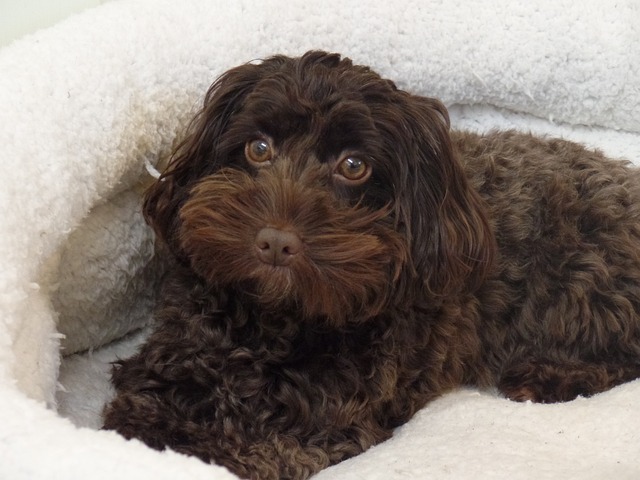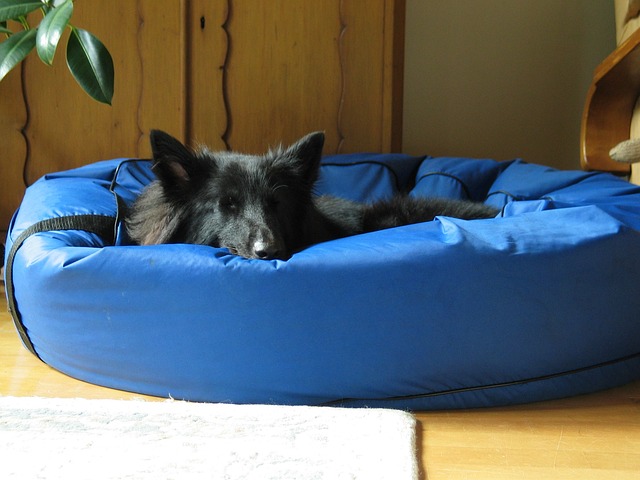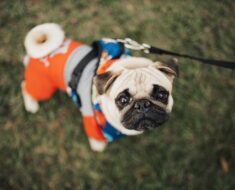Have you ever wondered why dogs circle their beds before finally curling up for a snooze? It’s a behavior that has intrigued pet owners for generations.
While it may seem like a mere quirk, there are scientific explanations behind this seemingly repetitive ritual.
By exploring the fascinating world of animal behavior and drawing upon research conducted by experts, we can uncover the reasons why dogs engage in this circling behavior.

In this article, we will delve into the captivating realm of canine instincts, evolutionary traits, and the biological factors that contribute to this intriguing pre-sleep routine.
How does circling help with survival?
Dogs have a natural instinct to circle their bed or the area where they plan to lie down before settling in. This behavior can be traced back to their ancestors, the wild canines, who used to live in the wild and needed to prepare a suitable resting spot.
There are a few reasons why dogs circle before lying down, and while it may not directly help with survival in their current domesticated environment, it has roots in their evolutionary history:
1. Safety and Comfort:
By circling, dogs may be instinctively trying to create a comfortable and safe sleeping area. In the wild, circling helped them trample down tall grass or vegetation, remove any potential hazards, and create a cozy spot free from twigs, rocks, or insects that could disturb their rest.
2. Scent Marking:
Dogs have scent glands in their paws, and by circling, they can spread their unique scent onto the ground. This behavior can serve as a way of marking their territory and creating a familiar scent that provides them with a sense of security.
3. Alignment:
Circling can also help dogs align their bodies in a way that promotes heat conservation or cooling, depending on the weather. By circling, they can find the most comfortable position that suits the temperature at that particular moment.
While these reasons made sense for wild canines, it’s important to note that domesticated dogs may continue to exhibit this behavior out of habit or instinct, even if their sleeping environment is already safe and comfortable.
Now see where the behavior come from in bed?
Where the Behavior Came From?
The behavior of a dog circling its bed before lying down can be traced back to their ancestral instincts. Dogs are descendants of wolves, and their wild counterparts would engage in similar behavior before resting.

In the wild, wolves would circle their sleeping area to perform several important functions:
1. Nesting:
By circling, wolves could trample down tall grass, leaves, or other materials to create a flattened and comfortable spot for rest.
This behavior helped them create a makeshift nest and remove any potential obstructions or uncomfortable objects from their sleeping area.
2. Scent Marking:
Wolves have scent glands in their paws, and circling allowed them to release their unique scent onto the ground. This scent marking served as a territorial signpost to other members of the pack, indicating that the area was claimed and occupied.
3. Safety and Security:
Circling helped wolves scan their surroundings and ensure there were no immediate threats or predators nearby.
By performing a quick survey of the area, they could assess the safety of their sleeping spot and minimize potential surprises while vulnerable during rest.
Although domesticated dogs no longer face the same survival challenges as their wild ancestors, these instincts are deeply ingrained in their behavior.
Even in a comfortable indoor setting, dogs may continue to circle their bed as a result of their genetic predisposition and ancestral habits.
8 Reason why does a dog circle its bed before lying down scientific method
Take a look at 8 reason why does a dog circle its bed before lying down or even pooping.
1. Safety While Sleeping
One reason why a dog circles its bed before lying down is to ensure safety while sleeping. This behavior can be traced back to their ancestral instincts. By circling, dogs create a comfortable and safe sleeping spot.
This instinctual behavior allows them to flatten the surface, remove debris, and check for potential dangers or intruders.
Circling helps dogs establish a secure environment, ensuring they can rest without the fear of hidden threats that could harm them while they sleep.
2. Clearing Snakes
Another possible reason why a dog circles its bed before lying down is to clear snakes or other potential threats from its sleeping area. Dogs have a keen sense of smell and can detect scents that humans may not perceive.
By circling their bed, they may be able to identify the presence of snakes or other small animals that could pose a danger.
This behavior allows them to clear the area of any potential threats and ensure a safe sleeping environment.
3. Marking Territory
A third reason why a dog may circle its bed before lying down is to mark its territory. Dogs have scent glands in their paws, and as they walk in a circular motion, they release pheromones that act as a form of territorial marking.
This behavior communicates to other animals that the specific area belongs to the dog.

By circling their bed, dogs are instinctively claiming the space as their own, creating a sense of familiarity and ownership, which can contribute to their overall comfort and security while resting.
4. Making a Comfortable Bed
A fourth reason why a dog may circle its bed before lying down is to make a comfortable sleeping spot. By circling, dogs engage in instinctive behaviors such as scratching, digging, and patting the surface.
These actions help them to adjust the bedding materials, fluff them up, and create a more comfortable area to lie on. Dogs may also knead or paw at the bed, similar to how cats knead blankets.
This behavior allows them to find the perfect position and texture that suits their comfort preferences, promoting a more restful sleep.
5. Temperature Control
A fifth reason why a dog may circle its bed before lying down is to regulate their body temperature. Dogs have a natural ability to sense and adjust their environment to maintain optimal comfort.
By circling, dogs can manipulate the bedding materials, such as blankets or cushions, to achieve the desired level of warmth or coolness.
They may push or pull the materials to create a suitable microclimate that helps them regulate their body temperature while they sleep, ensuring they stay cozy or find relief from heat as needed.
6. Identifying predators and unwanted bedmates
A sixth reason why a dog may circle its bed before lying down is to identify predators and unwanted bedmates. Dogs have a heightened sense of smell and can detect the presence of other animals or pests in their surroundings.
By circling their bed, they are able to sniff for any signs of potential predators, such as snakes or insects, and avoid sharing their sleeping space with unwanted bedmates like fleas or ticks.
This behavior allows them to ensure a safe and pest-free sleeping environment, promoting their overall well-being.
7. Searching for stragglers
A seventh reason why a dog may circle its bed before lying down is to search for stragglers. Dogs, especially those with a herding instinct, have a natural inclination to gather and organize.
By circling their bed, they are exhibiting a behavior reminiscent of rounding up or herding. This circling behavior allows them to scan their surroundings for any stray objects or toys that might have been left behind.
It helps satisfy their instinctual drive to gather and ensures that their sleeping area is clear of any potential clutter or objects that may disturb their rest.
8. Claiming their space
An eighth reason why a dog may circle its bed before lying down is to claim their space. Dogs are territorial animals, and circling their bed is a way of marking and asserting ownership over their sleeping area.
This behavior helps establish a sense of familiarity and security for the dog. By circling, they are essentially staking their claim on that specific spot, creating a sense of belonging and personal space.
It reinforces their sense of identity and provides them with a sense of comfort and confidence while they rest.
What This Means for Pet Dogs and Sleeping?
Dogs have a natural instinct to circle their sleeping area before settling down, which is a behavior that’s inherited from their wild ancestors. In the wild, this behavior helped to flatten down grass or foliage, making a comfortable bed and clearing the area of any potential dangers like snakes or insects.
In domesticated dogs, this circling behavior has become a routine part of their bedtime ritual. It serves a similar purpose as it did for their wild ancestors, helping to create a comfortable sleeping spot and clearing the area of any potential hazards.
Circling before lying down also helps to stretch the dog’s muscles and joints, making them feel more relaxed and comfortable. It may also be a way for dogs to mark their territory by leaving their scent behind.
As a pet owner, it’s important to provide your dog with a comfortable sleeping area that is safe and free of hazards. Providing a cozy bed with comfortable bedding can help to encourage your dog to settle down quickly and sleep soundly through the night.
Additionally, you should make sure that your dog’s sleeping area is in a quiet, peaceful location, away from any loud noises or disturbances that could disrupt their sleep.
Here check out best heated dog bed.
When Circling Means That Something Is Wrong
If a dog repeatedly circles its bed or displays excessive circling behavior before lying down, it could be an indication that something is wrong. Here are a few possible reasons for abnormal circling behavior:
1. Discomfort or pain:
Dogs may circle excessively if they are experiencing discomfort or pain. It could be due to an injury, arthritis, or an underlying health condition.
If you notice this behavior, it’s important to observe your dog for other signs of pain or discomfort and consult with a veterinarian if necessary.
2. Anxiety or stress:
Dogs may circle as a result of anxiety or stress. If your dog is exhibiting other signs of anxiety, such as restlessness, panting, or excessive licking, it’s important to identify and address the underlying cause.
Providing a calm and secure environment, along with possible behavioral training or professional help, can help alleviate anxiety-related circling.
3. Cognitive dysfunction:
In older dogs, circling behavior can sometimes be a symptom of cognitive dysfunction or canine dementia. Dogs with cognitive dysfunction may exhibit confusion, disorientation, and changes in their sleep-wake cycles.
If you suspect cognitive dysfunction, it’s best to consult with a veterinarian for proper diagnosis and management.
4. Obsessive-compulsive behavior:
Some dogs may develop obsessive-compulsive behaviors, such as excessive circling, due to genetics, boredom, or stress.
These behaviors can be managed through behavior modification techniques, environmental enrichment, and sometimes with the help of a professional dog trainer or behaviorist.

If you notice unusual or excessive circling behavior in your dog, it’s important to observe their overall behavior, look for additional signs of discomfort or distress, and consult with a veterinarian if you have concerns.
They can provide a proper evaluation and recommend appropriate steps to address the underlying issue.
When to call the vet
You should consider calling a veterinarian if your dog’s circling behavior before lying down is accompanied by any of the following signs:
- Visible signs of distress or pain: If your dog appears to be in pain, shows signs of discomfort, or vocalizes while circling, it’s important to seek veterinary attention. Signs of pain can include whimpering, yelping, panting excessively, or limping.
- Change in behavior: If your dog’s circling behavior is sudden and uncharacteristic, or if it’s accompanied by other changes in behavior such as lethargy, loss of appetite, aggression, or disorientation, it may be indicative of an underlying health issue that requires medical attention.
- Excessive circling: While some circling before lying down is normal, excessive or compulsive circling can be a cause for concern. If your dog circles excessively, appears unable to settle down, or seems distressed during the circling process, it’s best to consult a veterinarian.
- Other symptoms or abnormalities: If your dog displays additional symptoms such as vomiting, diarrhea, difficulty breathing, seizures, or any other concerning signs along with circling, it’s advisable to contact a veterinarian promptly.
Ultimately, as a pet owner, you know your dog best. If you are unsure whether your dog’s circling behavior is normal or if you have any concerns about their health or well-being, it’s always a good idea to err on the side of caution and consult with a veterinarian.
They can provide professional guidance, evaluate your dog’s specific situation, and recommend appropriate steps or necessary treatment.
Female dogs and circling
Female dogs may circle their bed or the area before lying down for a variety of reasons, including those mentioned earlier. However, there is one additional factor that can be specific to female dogs: nesting behavior.
Female dogs, particularly when they are pregnant or approaching their due date, may engage in nesting behavior. Nesting behavior involves circling, pawing, and rearranging bedding or other materials to create a comfortable and secure space for giving birth and caring for their puppies.
During pregnancy, female dogs have increased hormone levels and an instinctual drive to prepare a suitable den-like area for their upcoming litter. The circling behavior helps them assess and modify the environment to ensure the safety and comfort of their puppies.
If you have a female dog who is pregnant or nearing her due date, observing nesting behavior, including circling and rearranging bedding, is a normal and instinctive part of the maternal process.
It’s important to provide her with a quiet and secure space where she can nest comfortably and give birth.
If you have concerns about your pregnant dog’s nesting behavior or her overall health during pregnancy, it’s always best to consult with a veterinarian for guidance and support.
They can provide specific advice tailored to your dog’s needs and ensure a smooth and healthy pregnancy and delivery.
Here check out why does your dog dig at night?
Related faq’s
Are there other reasons why my dog may circle before laying down?
Yes, there can be other reasons why a dog may circle before laying down. Here are a few additional factors that may contribute to this behavior:
- Habit and comfort: Circling before lying down can simply be a habit or a learned behavior that dogs develop over time. It may make them feel more comfortable and help them settle into a specific spot. Some dogs may have learned this behavior from their previous experiences or by observing other dogs.
- Sensory exploration: Dogs have a highly developed sense of smell, and circling can serve as a way for them to explore and investigate their surroundings. By circling, they can gather more information about the area, detect scents, and assess the safety of the environment before settling down.
- Temperature regulation: Dogs may circle to find the most comfortable temperature for lying down. By circling, they can search for cooler or warmer spots depending on their needs. This behavior allows them to adjust their body temperature and find the optimal sleeping position.
- Anxiety or restlessness: In some cases, dogs may circle excessively due to anxiety, restlessness, or an inability to settle down. This behavior may be seen in dogs with separation anxiety, discomfort in their sleeping area, or certain medical conditions. If you suspect anxiety or restlessness as the cause, it’s important to address the underlying issue and provide appropriate support or training.
Remember, every dog is unique, and the reasons for circling before lying down can vary.
If you have concerns about your dog’s behavior or if the circling is accompanied by other unusual signs, consulting with a veterinarian or a professional dog trainer or behaviorist can provide more insight and guidance specific to your dog’s situation.
Does circling help my dog get comfortable?
Yes, circling can help dogs get comfortable before lying down. When dogs circle their sleeping area, it serves a few purposes that contribute to their comfort:
- Flattening the surface: Circling helps dogs flatten the bedding or sleeping area, making it more even and comfortable. By pawing at the surface and circling, dogs can create a suitable spot to lie down that is free from bumps or obstructions.
- Adjusting body position: During the circling process, dogs have an opportunity to find their preferred body position for resting. They can determine the direction, angle, and orientation that feels most comfortable to them. By circling, they can align their body and adjust their position accordingly.
- Stretching and relaxing: Circling before lying down allows dogs to stretch their muscles and joints. This stretching can help alleviate any tension or stiffness, making them feel more relaxed and comfortable when they finally settle down.
It’s important to note that while circling is a natural behavior for dogs, excessive or obsessive circling may indicate an underlying issue that needs attention.
If your dog seems excessively restless, distressed, or unable to find comfort even after circling, it’s advisable to consult with a veterinarian or a professional dog trainer to address any potential issues affecting their comfort and well-being.
Here check out why does your dog leave the bed in the middle of the night?
Does circling help with animals control their temperature?
Circling behavior in animals, including dogs, is not directly related to temperature control. Dogs primarily regulate their body temperature through panting, sweating through their paw pads, and seeking out cooler or warmer areas.
However, circling before lying down may indirectly contribute to temperature regulation in a couple of ways:
- Seeking optimal temperature: By circling, dogs can search for a comfortable spot that aligns with their preferred temperature. They may be instinctively trying to find a cooler or warmer area depending on their needs at that moment. For example, they may circle to find a cool spot on a hot day or to locate a warmer spot in colder temperatures.
- Creating air circulation: As dogs circle, they often kick up air movement around their body. This movement can help facilitate air circulation and promote better ventilation, which can indirectly aid in temperature regulation. By finding a well-ventilated area, dogs may be able to cool down or warm up more effectively.
It’s important to note that while circling may assist dogs in finding a comfortable temperature zone, it is not the primary method of temperature regulation for them.
They primarily rely on their physiological mechanisms, such as panting, to cool down or seeking warmth in colder environments.
If you have concerns about your dog’s ability to regulate their body temperature or if you notice signs of overheating or excessive cold, it’s recommended to provide them with appropriate environmental conditions and consult with a veterinarian for guidance on ensuring their comfort and well-being.
How does circling help our pet dogs?
Circling behavior in pet dogs can serve several purposes and provide certain benefits:
- Comfort and settling: Circling helps dogs create a comfortable spot to lie down. By pawing at and circling their sleeping area, dogs flatten the surface, making it more even and suitable for rest. This process allows them to find their preferred body position and orientation, helping them feel more settled and at ease.
- Scent marking and territory identification: Dogs have scent glands in their paws, and as they circle, they may leave their scent on the ground. This behavior serves as a way for dogs to mark their territory and leave their olfactory signature behind. It helps them establish a sense of ownership and familiarity in their sleeping area.
- Muscle stretching and relaxation: The circling process involves physical movement, which allows dogs to stretch their muscles and joints. By engaging in this activity, dogs can alleviate any tension or stiffness, promoting relaxation and comfort when they finally lie down.
- Preparing a safe environment: Circling can also be an instinctual behavior inherited from wild ancestors. In the wild, animals often circle to clear their sleeping area of potential dangers, such as snakes or insects. While domesticated dogs may not face the same threats, this behavior is retained as an ancestral instinct to ensure a safe and secure sleeping spot.
It’s important to note that excessive or compulsive circling may be a sign of underlying issues, such as anxiety, discomfort, or medical conditions.
Monitoring your dog’s circling behavior and overall well-being is recommended, and if you have any concerns, consulting with a veterinarian can provide further guidance and assistance.
Here check out why does your dog like to go in your bed?
What if the circling is excessive?
If your dog’s circling behavior is excessive or becomes a repetitive and compulsive pattern, it may be a cause for concern.
Excessive circling could indicate an underlying issue that needs to be addressed. Here are a few potential reasons for excessive circling:
- Medical condition: Excessive circling can sometimes be a symptom of certain medical conditions, such as neurological disorders, ear infections, pain, or sensory issues. It’s important to rule out any underlying health problems by consulting with a veterinarian. They can conduct a thorough examination and recommend appropriate tests or treatments if necessary.
- Anxiety or stress: Excessive circling can also be a sign of anxiety or stress in dogs. If your dog shows other signs of anxiety, such as restlessness, pacing, panting, or destructive behavior, it’s important to address the underlying anxiety and provide appropriate support. This may involve behavioral training, environmental modifications, or in some cases, professional help from a dog behaviorist.
- Obsessive-compulsive behavior: Some dogs may develop obsessive-compulsive behaviors, including excessive circling, due to genetic predisposition, boredom, or anxiety. Obsessive circling may require intervention to help redirect their behavior and alleviate the underlying anxiety or compulsions. Consulting with a veterinarian or a professional dog trainer or behaviorist can provide guidance on managing and modifying these behaviors.
If you observe excessive circling in your dog, it’s advisable to document the frequency and duration of the behavior and consult with a veterinarian.
They can evaluate your dog’s specific situation, assess for any underlying issues, and provide appropriate recommendations for management or treatment.
Early intervention and addressing the underlying cause are essential for your dog’s well-being and to prevent the behavior from escalating further.






